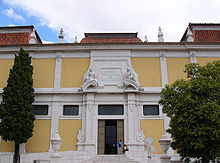Museu Nacional de Arte Antiga
The Museu Nacional de Arte Antiga ( MNAA ; German: National Museum of Ancient Art ) is an art museum in Lisbon . It is considered one of the most important museums in Portugal .
history

After the works of art in numerous churches and monasteries had been widely dispersed and partially destroyed since the secularization in 1834, a retrospective on Portuguese and Spanish decorative art was put together in 1882 . The exhibition was shown in the Alvor Palace and was a great success. The Portuguese government then decided to merge the state holdings for a permanent exhibition in the Alvor Palace. In 1884 the Museu Nacional de Arte Antiga was officially opened.
The starting point of the collection were the exhibits from the exhibition of 1882. After the proclamation of the republic in 1910, the collection was expanded to include large holdings from the property of the royal family. Since then, the collection has continued to grow through donations and foundations.
In 1893, the archaeological collections that can be seen today in the Museu Nacional de Arqueologia were relocated . In 1911, contemporary art was transferred to the newly founded Museu do Chiado .
collection
A major focus of the permanent exhibition are works by Portuguese artists. A masterpiece is the St. Vincent altar by Nuno Gonçalves , which was probably made between 1450 and 1460 and consists of six panels with a total of 60 portraits. Other important Portuguese such as Jorge Afonso and Vasco Fernandes are also represented in the collection.
In addition to the Portuguese artists, numerous works by other artists also establish the museum's reputation. By Hieronymus Bosch which is Temptation of St. Anthony to see by Albrecht Dürer St. Jerome . Also represented are for example Pieter Brueghel the Younger , Piero della Francesca , Jan Gossaert , Hans Holbein the Elder , Pieter de Hooch , Quentin Matsys , Hans Memling , Raffael , Diego Velázquez and Francisco de Zurbarán .
In addition to the painting collection, the museum contains sculptures from seven centuries. In addition, masterpieces of gold and silversmithing are shown. A gold monstrance with enamel inlays attributed to the poet Gil Vicente is said to have been made from the first gold that Vasco da Gama brought to Portugal from India. The glass and ceramic inventory includes first pieces of Vista Alegre porcelain.
building
The museum is located above the Tejo embankment from downtown Lisbon to Belém . The building was erected in the 17th century and served as the seat of Count Alvor. Later the building belonged to the brother of the Marquês de Pombal . In 1918 the ruins of the adjoining St. Albert Monastery were torn down and an extension was built on the Alvor Palace, which is now also used by the museum together with the preserved Baroque chapel. Today's main entrance is in this new building on the monastery grounds. Only this new building has two upper floors, on which parts of the permanent exhibition can be seen. Under the old Alvor Palace there is a basement that houses the museum restaurant, a lecture hall and rooms for temporary exhibitions.
literature
- Hans Strelocke: Portugal . DuMont Art Guide, Cologne 1982 ISBN 3-7701-1369-1
Web links
- Official website (Portuguese / English)
- Museu Nacional de Arte Antiga. Brief presentation on the website of the National Monument Authority Direção Geral do Património Cultural (DGPC) (Portuguese / English)
Coordinates: 38 ° 42 ′ 15.9 " N , 9 ° 9 ′ 42.5" W.
